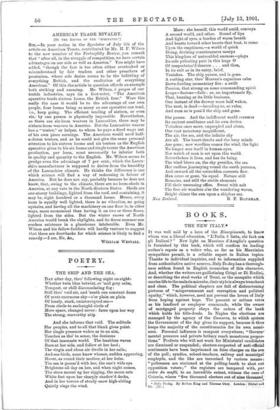AMERICAN TRADE RIVALRY.
[To Tim EDITOR OP TIM "SPECTATOR.") Snr,—In your notice in the Spectator of July 6th of the article on American Trusts, contributed by Mr. H. F. Wilson to the new number of the Fortnightly Review, you remark that "after all, in the straggle of competition, we have certain advantages on our side as well as America." You might have added, "though the fact is too often either overlooked or misunderstood by fair traders and other preachers of pessimism, whose sole desire seems to be the belittling of everything British, and the exaltation of everything American." Of this the article in question affords an example both striking and amusing. Mr. Wilson, a propos of our textile industries, says (in a foot-note), "The American operative tends sixteen looms, the British four." Were this really the case it would be to the advantage of our own people, four looms being as many as one operative can tend, i.e., keep going. The efficient tending of sixteen, or even
by one person is physically impossible. Nevertheless, as there are six-loom weavers in Lancashire, there may be sixteen-loom weavers in America. But the Lancashire weaver has a "tenter," or helper, to whom he pays a fixed wage out of his own piece earnings. The American would need half- a-dozen tenters, and as he could not give the same personal attention to his sixteen looms and six tenters as the English operative gives to his six looms and single tenter the American production, per loom, must necessarily be inferior both in quality and quantity to the English. Mr. Wilson seems to grudge even the advantage of 7 per cent., which the Lanca- shire manufacturer is supposed to derive from the humidity of the Lancashire climate. He thinks the difference is one which science will find a way of redressing in fai-our of America. But he does not say, probably because he does not know, that, owing to the climate, there are no loom-sheds in America, at any rate in the North-Eastern States. Sheds are one-storey buildings, lighted from the roof, and containing, it may be, eight hundred or a thousand looms. Hence, every loom is equally well lighted, there is no vibration, no going upstairs, and having all the machinery on one floor is, in other ways, more economical than having it on two or three floors, lighted from the sides. But the winter snows of North America would break the skylights, and its fierce summer sun renders existence in a glasshouse intolerable. Even Mr. Wilson and his fellow-faddists will hardly venture to suggest that these are drawbacks for which science is likely to find a remedy.—I am, Sir, &C., WILLIAM WESTALL.






































 Previous page
Previous page